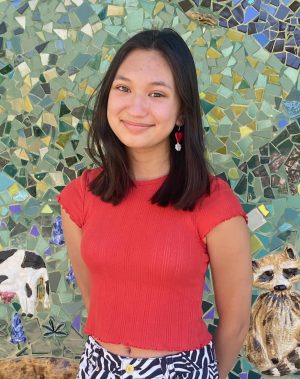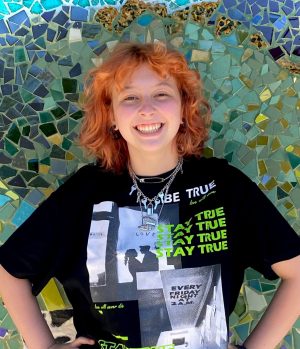AP Research projects showcase seniors’ interests
June 7, 2021
Finance. Insect-based foods. Drugs. Personality traits. Although these topics may seem to have nothing remotely in common, there is one class that encompasses them all. In Advanced Placement Research (APR), seniors complete a yearlong research project on a topic of their choice as part of the two-year AP Capstone Program, including AP Seminar and AP Research. According to APR teacher Emily LaTourrette, the program stands out as a class that provides students with research and analysis skills not often taught in the common core curriculum.
“[APR is] great because we’re guiding them through a process and skills that are very high-level, but because the content is something that they’ve chosen, there’s so much enthusiasm and passion,” LaTourrette said.
In May, students gave oral presentations and completed a paper on their research to submit to the College Board. Here is a look into the projects and experiences of four APR students after a year long process.
Karin Amir
Senior Karin Amir chose to do her APR project on evaluating the feasibility of incorporating financial lessons into the Redwood math curriculum, a decision primarily motivated by Redwood’s lack of financial studies.

“When I got [to my AP Economics class during] the first week, I realized that I was … almost 18 and [that] was the first time I’d been formally introduced in my education to any sort of financial topics, which I found to be a little bit ridiculous,” Amir said.
Despite her immediate passion for the subject, Amir found that the most difficult part of the project was settling on the topic to be her focus for the entire year. While students like Amir found this process to be tough, APR teacher Ernesto Diaz believes that the independence unique to the class eventually fosters a more creative environment for students.
“I think the openness of the very beginning is very scary because the students usually come to the program trained to do specific requirements that their teachers give them, but here they have complete freedom to explore what they do,” Diaz said.
To conduct her research, Amir talked to different math and economics teachers to see if incorporating finance lessons into math classes was realistic. She found that the most feasible way to incorporate finance lessons was through smaller activities, instead of an entire unit, because it is already difficult for teachers to fit in all math units. After completing this project, Amir believes that APR is a class that every student should consider taking.
“I think in some AP classes, there’s a demographic of kids that you can pinpoint that would take a specific class, but what’s great about AP research is that there’s really no demographic,” Amir said “It’s really just based on your personal interests.”
Wesley Griggs
Senior Wesley Griggs decided to do her project on the willingness of high school students to pay for insect-based food if nutritional information is displayed.

“I was really intrigued [after seeing insect-based food at a museum], and I had never heard of anything like it before. I realized that [the insect-based food] had a lot more protein than I was used to, so this piqued my interest in insect-based foods and their connection to sustainability,” Griggs said.
Griggs explored which types of information would cause people to be more interested in trying these types of foods. Since a key part of the APR project is to research something that has not been explored before, Griggs chose to look at this topic from a marketing perspective.
“There’s already been research about people’s acceptance of this type of diet overall, so I wanted to bring a marketing aspect to it and see if the packaging and information that was displayed about the product was changed, then how that would influence people’s willingness to buy the actual product,” Griggs said.
In her research, Griggs found that when no nutritional information was provided, 30 percent of students were willing to pay for cricket-based pasta. In contrast, when nutritional information was included, 45.8 percent of students were willing to pay. She also found that protein levels, rather than vitamin B12 and dietary fiber amounts, increased this percentage, potentially due to the emphasis on protein over other vitamins and fibers in 21st-century diet culture and healthy eating habits. Griggs found that this information could be used to help insect-based marketers.
Bella Petrini
“[Over quarantine] my mom always yelled at me about going on the internet too much. I decided to do a project and prove her wrong that our generation isn’t on the internet too much and we have good personalities and social skills,” senior Bella Petrini said.

Petrini’s project focused on how the internet influenced the personality traits of younger generations. Petrini became inspired to learn more about this topic over quarantine, as they found themself interested in whether the stereotype of chronically online teenagers with personality traits that were influenced by the internet was true.
Through their research, Petrini found out that on a scale of the Big 5 Personalities in psychology that are essential traits to building personalities — extraversion, conscientiousness, agreeableness, openness to experience and neuroticism — younger generations scored, on average, lower than older generations. However, they proved certain stereotypes wrong about younger generations, specifically in regards to social skills.
“Generation Z is considered [by many] to be less extroverted and less positive because we spend so much time on our computers, but my findings suggested that Gen Z has a higher rate of extroversion than the Baby Boomers,” Petrini said.
As Petrini reflects back on their research, they found that the results of their project differ from previous ideas, showing that modern teens’ personalities were not as different from those of older generations.
“I thought [the data] was really cool because it goes against cultural perceptions of our generation,” Petrini said.
Asal Razavizadeh
“I was watching ‘Euphoria,’ and I thought about [the drug use] because I heard some of my friends being like, ‘Oh my God, like this makes me want to try drugs’ [while other] people [were] like, ‘This terrifies me,’” senior Asal Razavizadeh said.

After hearing other teens’ opinions about certain popular shows and movies, Razavizadeh decided to conduct research on students’ reactions to drug use in both television and movies and its psychological effects.
Razavizadeh reached out to around 200 students at Redwood to understand what emotional response they had when watching different media portrayals of drug use, such as in “13 Reasons Why” and “Beautiful Boy.” She found that many people reacted differently to media based on how the drug use was filmed, whether it was with negative or positive connotations.
“In ‘Euphoria’ there are lots of bright colors and makeup, and then [in] ‘Beautiful Boy’ every time there are drugs, it’s gray and gloomy and the main character’s on the ground,” Razavizadeh said. “[The shows and movies] varied and [so did the way] people responded.”
In her study, students said that depending on the way the drugs were depicted, as either fun or depressing, shifted the way they looked at substance use as either persuasively positive or frighteningly educational. Through her research, Razavizadeh found a specific correlation between the depiction of drugs in media and adolescent perspective of drug use.
Beyond APR
Diaz discusses that, although these projects do not necessarily have future implications, the passions found and skills learned sometimes influence what students choose to do in college and beyond.
“In college, [this program] usually makes [students] feel that they are running circles around their peers because they’re used to doing work regarding research, [are] self-guided and motivated. That experience actually gets internalized,” Diaz said.
According to LaTourrette, students learn many skills about research and data collection for college courses through APR, but the class’ benefits extend beyond surface-level expertise.
“I think even more than [the academics] it’s also about them figuring out who they are and what they’re interested in. They’re not the super academic skills, they’re more of the personal skills of finding what you’re passionate about [and] finding out who you are that lead you to what you want to do later,” LaTourrette said.